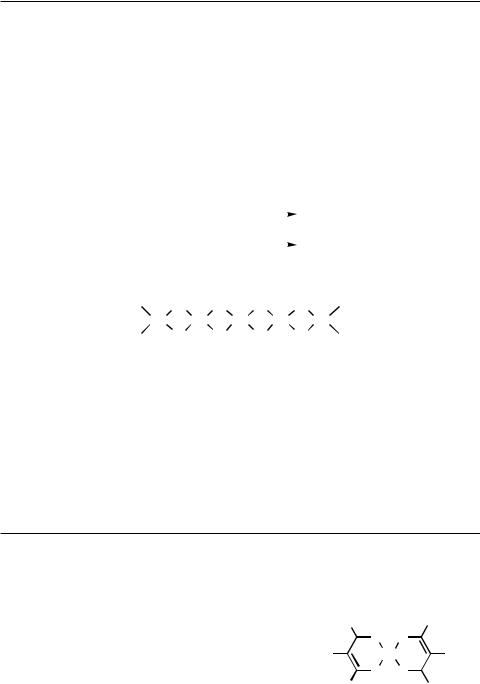

II.2.2 Palladium Complexes Containing
Halogen and Oxygen Ligands
EI-ICHI NEGISHI
As indicated in Sect. II.2.1, Pd(II) complexes containing halogen and/or oxygen ligands, such as PdCl2 and Pd(OAc)2, are some of the most commonly used starting Pd compounds for the preparation of a wide range of Pd precatalysts and catalysts.
A. PALLADIUM(II) COMPLEXES CONTAINING HALOGEN LIGANDS
Although PdCl2 is by far the most widely used palladium halide, there are several other commercially available palladium halides as shown in Table 1.
Palladium chloride is prepared by treating Pd metal with Cl2 at elevated temperatures. It exists as an essentially linear doubly Cl-bridged polymer 1.[1] Palladium bromide is prepared from Pd and Br2 in the presence of nitric acid, while PdI2 is normally prepared by treatment of PdCl2 with iodide ions.[1]
One of the inconveniences associated with the use of these palladium halides is their low solubility in aqueous and organic media. Although PdCl2 is soluble in water, it is insoluble in most of the organic solvents, unless some chemical transformations can readily take place, as in the cases of nitriles (Scheme 1). This inconvenience can readily be overcome by addition of alkali metal chlorides (e.g., LiCl). Addition of 2 equiv of LiCl to a suspension of PdCl2 in a suitable organic solvent (e.g., THF) dissolves PdCl2 through the formation of Li2PdCl4 (Scheme 1), which may then be used as a solubilized form of PdCl2 for the preparation of various other Pd complexes, as detailed in later sections.
B. PALLADIUM(II) COMPLEXES CONTAINING OXYGEN LIGANDS
Some of the commercially available Pd(II) complexes containing oxygen ligands are shown in Table 2.
Palladium oxide (PdO) can be prepared from Pd and O2. It may be obtained as a yellow gelatinous hydrate (PdO n H2O) that dries to a brown and less hydrated species. Upon further heating it eventually becomes black, but it cannot be completely dehydrated without loss of oxygen.[1]
Handbook of Organopalladium Chemistry for Organic Synthesis, Edited by Ei-ichi Negishi ISBN 0-471-31506-0 © 2002 John Wiley & Sons, Inc.
43

44 II Pd-COMPOUNDS: STOICHIOMETRIC PREPARATION
TABLE 1. Some Commercially Available Pd(II) Complexes Containing Halogen Ligands a
Compound |
|
Formula Weight |
|
Other Descriptions |
|||
|
|
|
|
|
|
|
|
PdCl2 |
|
177.31 |
|
|
|
Rust-colored solid |
|
PdBr2 |
|
266.22 |
|
|
|
Black solid |
|
PdI2 |
|
360.21 |
|
|
|
Black solid |
|
Li2PdCl4 n H2O |
|
262.09 n H2O |
|
Hygroscopic |
|||
Na2PdCl4 |
|
294.19 |
|
|
|
|
|
K2PdCl4 |
|
326.41 |
|
|
|
Brown powder |
|
K2PdBr4 |
|
504.21 |
|
|
|
Reddish-brown powder |
|
(NH4)2PdCl4 |
|
284.29 |
|
|
|
Reddish-brown powder |
|
a (i) Aldrich Catalog Handbook of Fine Chemicals 1998–1999. (ii) Strem Chemicals, Inc. Catalog (No. 17) |
|||||||
1997 – 1999. |
|
|
|
|
|
|
|
(PdCl2)n |
+ |
2n MeCN |
|
|
|
n Cl2Pd(MeCN)2 |
|
|
THF |
||||||
(PdCl2)n |
+ |
2n LiCl |
|
|
n Li2PdCl4 |
||
Scheme 1 |
|
||||||
|
|
|
|
|
|||
|
|
Cl |
Cl |
|
Cl |
|
Cl |
|
|
Pd |
Pd |
Pd |
Pd |
Pd |
|
|
|
Cl |
Cl |
|
Cl |
|
Cl |
|
|
|
|
1 |
|
|
|
By far the most widely used Pd—O compound is Pd(OAc)2. This compound can be prepared by the treatment of Pd sponge or PdO(H2O)n with HOAc or glacial HOAc. It my also be prepared by the reaction of Pd(NO3)2 with glacial HOAc. Pd(NO3)2 may, in turn, be prepared by the reaction of Pd with HNO3. Various other Pd—O compounds [e.g., Pd(acac)2] may be prepared from Pd(OAc)2 and PdX2 (X Cl or Br) by appropriate substitution reactions.
TABLE 2. Some Commercially Available Pd(II) Complexes Containing Oxygen Ligandsa
Compound |
Formula Weight |
Other Descriptions |
|||||
|
|
|
|
|
|
||
PdO |
122.40 |
Black Poweder, mp 870 °C |
|||||
Pd(OH)2 on C |
— |
Pearlman’s catalystb |
|
|
|
||
Pd(OAc)2 |
224.49 |
Orange-brown solid, mp 205 °C(dec.) |
|||||
Pd(OCOC2H5)2 |
252.55 |
CF3 |
|
|
|
CF3 |
|
Pd(OCOCF3)2 |
332.43 |
|
|
|
|||
|
|
O |
O |
||||
Pd(acac)2 |
301.62 |
|
|
||||
H |
Pd |
|
|
H |
|||
Pd[OC(CF3)"CHOCOCF3]2 (2) |
520.51 |
|
|
||||
|
|
O |
O |
|
|
||
Pd(NO3)3in HNO3 |
|
|
|
|
|
||
|
CF3 |
2 |
|
|
CF3 |
||
PdSO4 |
202.46 |
|
|
||||
|
|
|
|
|
|
|
|
a (i) Aldrich Catalog Handbook of Fine Chemicals, 1998 – 1999. (ii) Strem Chemicals, Inc. Catalog (No. 17)
1997 – 1999.
II.2.2 PALLADIUM COMPLEXES CONTAINING HALOGEN AND OXYGEN LIGANDS 45
Palladium hydroxide on C, typically 20 wt% Pd (dry basis), is commonly called Pearlman’s catalyst.[2] It has been reported to be particularly active for hydrogenolysis of benzyl–nitrogen bonds and effective even in cases where other Pd/C catalysts are not.
REFERENCES
[1]F. A. Cotton and G. Wilkinson, Advanced Inorganic Chemistry, 5th ed., Wiley, New York, 1988, 1455 pp.
[2]M. Fieser, Reag. Org. Synth., 1992, 16, 269.
